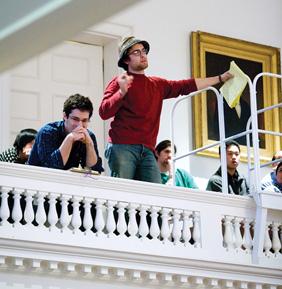 A student poses a question. |
By last summer, the Amherst endowment had reached an all-time high of $1.7 billion, representing a 5-percent
increase in value over the previous year.
“We actually felt quite good,” says Bill Ford ’83, a member of the Amherst Board of Trustees and chair of its investment committee. “And then, the world turned against us.”
Ford spoke in February at a forum for students, faculty and staff in a crowded Johnson Chapel. He, along with two other trustees—board chairman Jide Zeitlin ’85 and budget and finance committee chairman Steven Gluckstern ’72—discussed and answered questions about the college’s endowment, investment strategy and current and pending budget cuts.
The endowment fell 26 percent in value, to $1.26 billion, during the first half of the current fiscal year, which began July 1, 2008. (Despite those losses, the performance was still better than market benchmarks.) Administrators are predicting that, by the end of June, the endowment could be down as much as 30 percent for the fiscal year. For planning and projection purposes, the return projections are for 0-percent growth next fiscal year and 5-percent growth the following year.
The college’s current operating budget is around $155 million, up from about $80 million 10 years ago. (The increases to the budget followed gains in the endowment.) About half of the $155 million goes to salaries and benefits for faculty and staff members. The other big chunk of the pie—21 percent—is for student aid and academic awards.
Thanks to many years of high returns, the proportion of the budget that is funded by the endowment has also grown, reaching 35 percent this year. “The budget’s dependency on the performance of the endowment and financial markets is much, much greater than it was only 10 years ago,” Ford said. Given recent losses, that level of dependency is no longer sustainable. “The pattern by which we enjoyed the growth from the last 10 years cannot sustain us for the next 10 years,” Gluckstern said.
 Jide Zeitlin '85 (right) and Bill Ford '83 at the forum. |
The administration has already announced a salary freeze for next fiscal year and a reduction in the number of visiting faculty, and has decided to hold off on filling some open positions. As a result, the administration has been able to reduce next year’s projected budget by about 10 percent without making cuts to financial aid and while continuing to hire new faculty. Long-term plans will still allow for growth in such areas as financial aid and the faculty, Gluckstern said, and for things like new buildings.
Additional revenue will come from increasing the size of the student body by 100 over the next four years. Because of recent dorm renovations, the college already has space for more students. Also, the college has issued a $100 million, fixed-rate, taxable bond. That debt will help fund next year’s operating budget, taking the pressure off of the endowment.
In addition, all departments have been making cuts to non-salary spending. For example, offices have been delaying the purchase of new computers and other equipment. Departments have also reduced travel and postage costs and paper usage.
In March, the student body voted overwhelmingly to donate $50,000 for financial aid, $20,000 to help maintain staff pay among Amherst’s lowest-paid employees and $30,000 for student programming. The money will come from a reserve fund of unspent money generated by student activity fees from previous years. (See “Chipping in,” page 5.)
Near the end of February’s open forum, one student asked whether it’s reasonable to assume that cuts will be made to the largest pieces of the budget pie: salaries, benefits and financial aid. “No, I don’t think that’s a fair assumption,” Gluckstern replied. “It’s not a foregone conclusion that there are less faculty, less staff, less student aid.... I think it’s a fair statement that, over a 10-year period, the growth in all those areas that we might have wanted to have—that we can’t have all that growth.”
Zeitlin said the board has no specific plan for how to save money in the short term. “We almost certainly will, in some form or another, slow down the rate of growth in compensation,” he said. “I don’t know what form that takes.” He promised that the board has no secret list of what to cut. “The board doesn’t have an agenda here other than to make sure within 10 years we get back to financial equilibrium. We don’t have answers. Those answers have got to come from you.”
Photos by Samuel Masinter '04